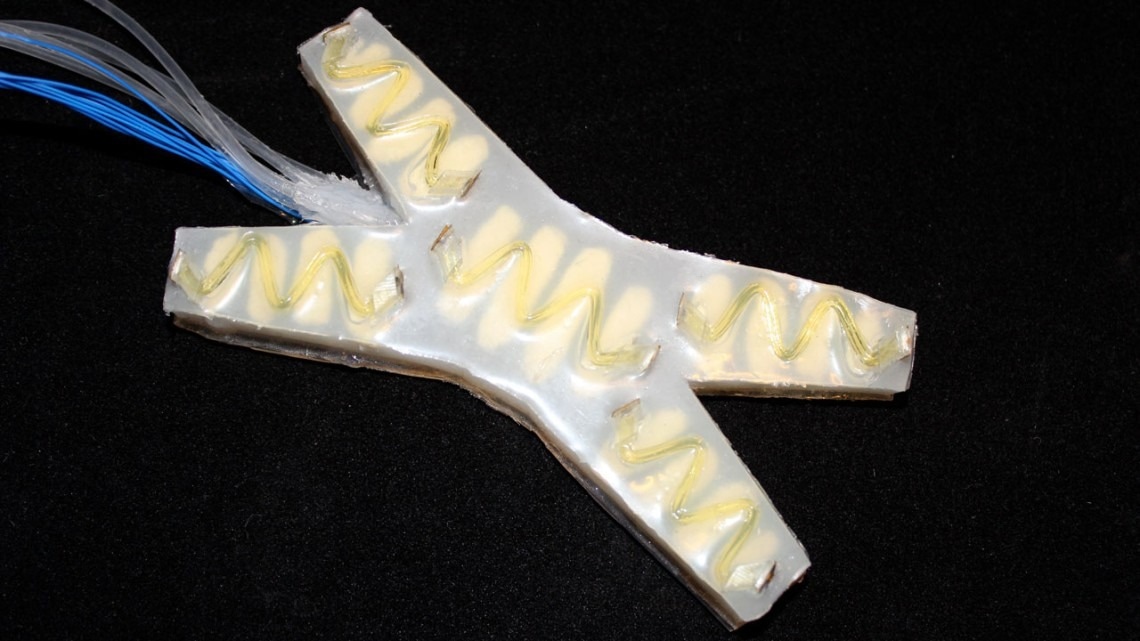Deep underwater or distant outer space are places that humans will face difficulty in reaching. Hence, if robots are going to plunge into remote environments like these, it is not just enough for them to have only power and a way to get there, they will also need to take proper care of themselves.
 Researchers installed SHeaLDS—self-healing light guides for dynamic sensing—in a soft robot resembling a four-legged starfish and equipped it with feedback control. After the researchers punctured one of its legs, the robot was able to detect the damage and self-heal the cuts. Image Credit: Cornell University.
Researchers installed SHeaLDS—self-healing light guides for dynamic sensing—in a soft robot resembling a four-legged starfish and equipped it with feedback control. After the researchers punctured one of its legs, the robot was able to detect the damage and self-heal the cuts. Image Credit: Cornell University.
A research team headed by Rob Shepherd, Associate Professor of Mechanical and Aerospace Engineering at Cornell Engineering, integrated optical sensors along with a composite material to engineer a soft robot that can exhibit the potential to detect when and where it was injured—and then heal by itself on the spot.
Their study was published in the Science Advances journal on December 7th, 2022. The study’s lead author is a doctoral student Hedan Bai.
Our lab is always trying to make robots more enduring and agile, so they operate longer with more capabilities. The thing is, if you make robots operate for a long time, they’re going to accumulate damage. And so how can we allow them to repair or deal with that damage?
Rob Shepherd, Associate Professor, Mechanical and Aerospace Engineering, Cornell Engineering
The initial step for such a repair to happen is that the robot should be capable of determining that there is, in fact, something that requires to be fixed.
For several years, Shepherd’s Organic Robotics Lab has used stretchable fiber-optic sensors to create soft robots and associated components—right from the skin to wearable technology—as agile and highly practical.
As far as fiber-optic sensors are concerned, light emitted from a LED is transmitted via an optical waveguide, and a photodiode detects variations in the beam’s intensity. This can be done to identify when the material is being distorted. The technology’s one of ethics is that waveguides still have the potential to propagate light if they are being subjected to getting cut or punctured.
The sensors were integrated with a polyurethane urea elastomer by the scientists. This included disulfide exchanges, for power and also hydrogen bonds, for quick healing.
The consequent SHeaLDS—self-healing light leads for dynamic sensing—offers trustworthy dynamic sensing, which is damage-resistant, and can also self-heal from cuts at room temperature without any external intervention.
For the technology to be illustrated, the scientists installed the SHeaLDS in a soft robot similar to a four-legged starfish and fitted it with feedback control. Once the scientists punctured one of its legs six times, the robot had the potential to detect the damage and self-heal each cut in around a minute. Also, the robot could separately adapt its gait depending on the damage sensed by it.
While the material seems to be sturdy, it is not unbreakable.
They have similar properties to human flesh. You don’t heal well from burning, or from things with acid or heat, because that will change the chemical properties. But we can do a good job of healing from cuts.
Rob Shepherd, Associate Professor, Mechanical and Aerospace Engineering, Cornell Engineering
Shepherd has a plan of combining the SHeaLDS with machine learning algorithms that identify tactile events to finally create “a very enduring robot that has a self-healing skin, but uses the same skin to feel its environment to be able to do more tasks.”
The study was co-authored by a doctoral student named Young Seong Kim.
The study was financially supported by the Air Force Office of Scientific Research, the NASA Innovative and Advanced Concepts program, and the National Science Foundation EFRI program.
Journal Reference:
Bai, H., et al. (2022) Autonomous self-healing optical sensors for damage intelligent soft-bodied systems. Science Advances. doi.org/10.1126/sciadv.abq2104